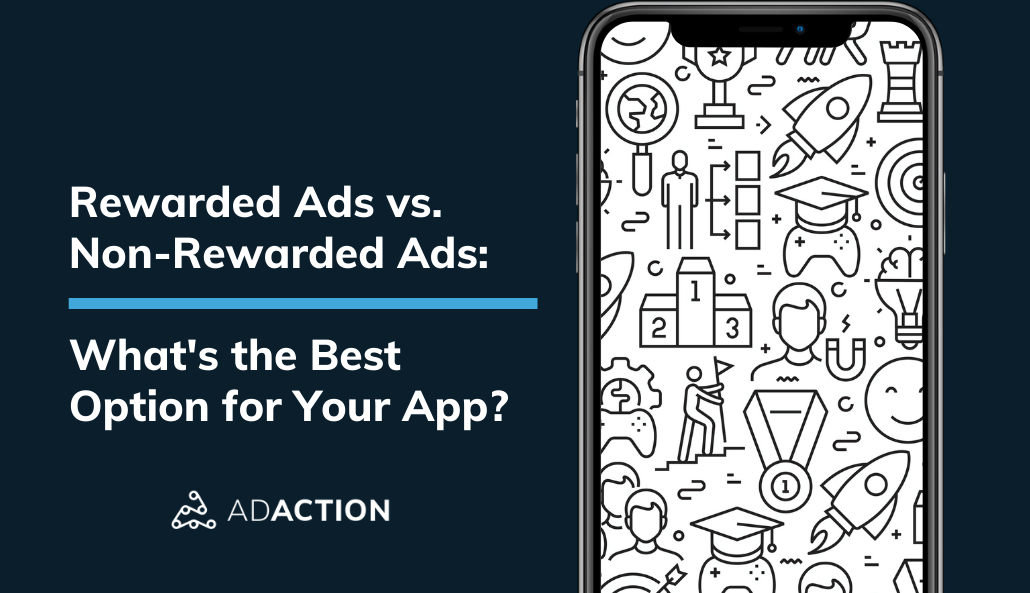To reward or not reward is the question. App marketers have many user acquisition (UA) tactics at their disposal, and there’s been much debate around rewarded ads vs. non-reward ads. Is one better than the other in terms of quality? Would a hybrid approach enable you to optimize app installs? Let’s look at the differences between reward advertising and non-rewarded and when you should use one or both.
What Are Rewarded Ads?
The rewarded model, also called sponsored or incentivized, rewards a user in exchange for completing an action. Typically, that action is installing an app. There are other engagements, like downstream events (i.e., registrations, free trials, subscriptions, orders, etc.). Once the user takes action, she receives an award, such as virtual currency, upgrades, discounts, or other offers.
What Are Non-Rewarded Ads?
A non-rewarded ad, or non-incentivized, serves as a standard promotion without any rewards for installing or taking an action. Because there’s no reward, users are taking action based on interest. However, you have no assurances they’ll stay and engage.
UA Campaigns: Rewarded or Non-Rewarded?
In a UA campaign, what’s more advantageous, rewarded or non-rewarded ads?
Reward Advertising Pros
- Volume: You’ll be able to attract more installs with rewarded ads faster. By focusing on ads that appeal to your ideal user base, your app and reward should be boost installs.
- Cost-effective: You’re working on a cost per install (CPI) model, so you’re only paying when users complete the install. In most circumstances, the CPI of rewarded ads is less than for non-rewarded ads.
- Organic lift: Rewarded traffic allows you to drive installs at a higher velocity, which can positively impact app chart ranking. In turn, your app is more visible to users, leading to additional organic installs.
- Re-engagement: After install, you can still leverage rewarded advertising. Use them to keep user engagement steady. Based on user behavior, disperse ads users will appreciate.
Reward Advertising Cons
- Retention: Since you incentivized the install, long-term retention may be more challenging. Incentivizing can change the user’s intent or motivation for downloading an app.
Non-Reward Advertising Cons
- Retention: Since you incentivized the install, long-term retention may be more challenging. Incentivizing can change the user’s intent or motivation for downloading an app.


Non-Reward Advertising Pros
- Greater user lifetime value (LTV): While you are directing users with an ad, they choose to install without an incentive. A genuine interest and need lead to higher LTV.
- Re-engagement: You can use non-rewarded ads for re-engagement as well. They can be reminders to users, like mentioning exclusive features or offers.
Non-Reward Advertising Cons
- Higher CPI: As noted, non-rewarded ads often have a higher CPI because the volume is less.
- Fewer overall installs: Non-rewarded ads will likely result in fewer overall installs. It may also take considerably longer to see results with these campaigns.
UA Campaigns: The Hybrid Model
To truly optimize your UA campaigns, consider a hybrid model that looks like this. Start with rewarded traffic campaigns to drive high volume on the installs. Then follow with non-rewarded ads for that set of users to re-engage and retain.
Additionally, use reward advertising as part of your evergreen strategy to drive consistent acquisition of users. Leverage them to hit deep funnel events and visibility during seasonal periods or other critical timeframes.
Maximize UA with Rewarded and Non-Rewarded Ads
There are opportunities to maximize UA and hit your goals with rewarded and non-rewarded ads. To ensure you get the best results, partner with our team of mobile app marketers to develop a strategy that fits with your audience and objectives. Connect with our team today to learn more.


